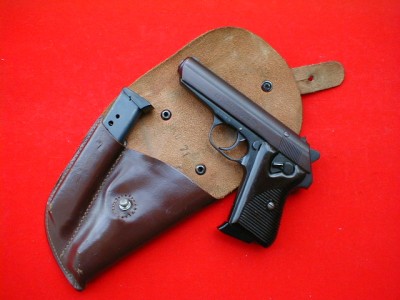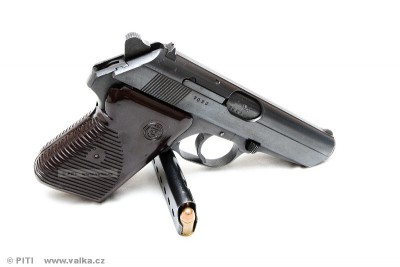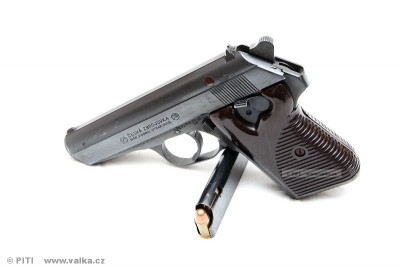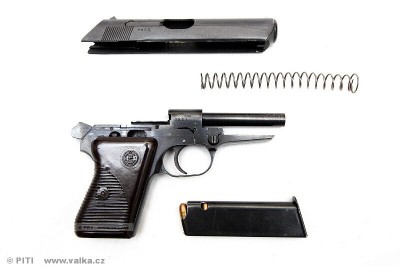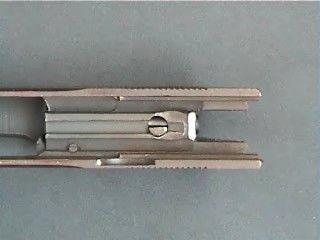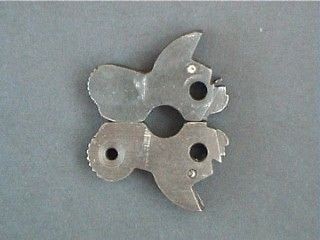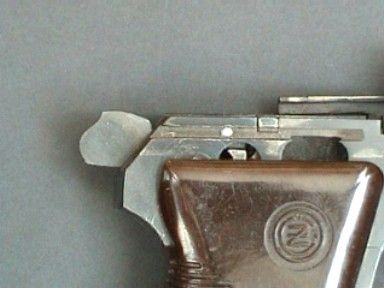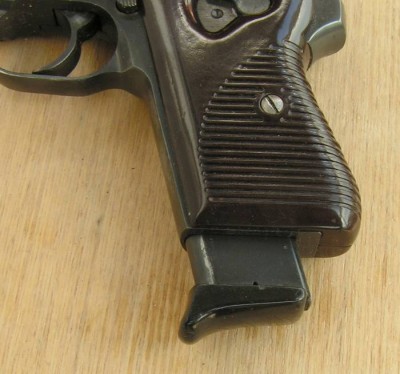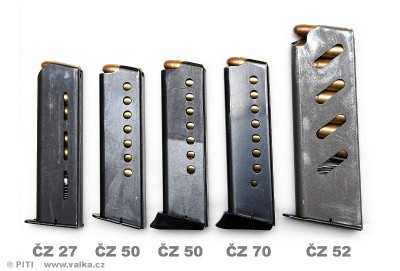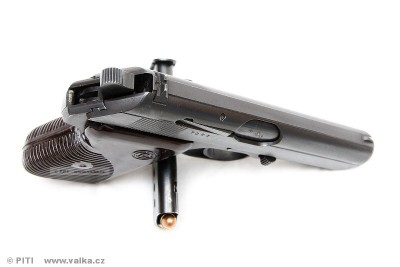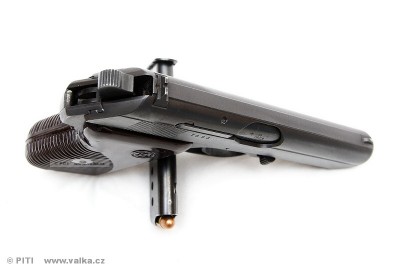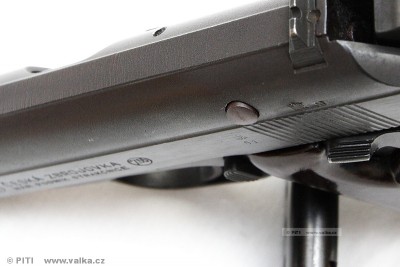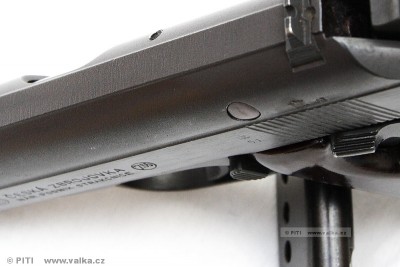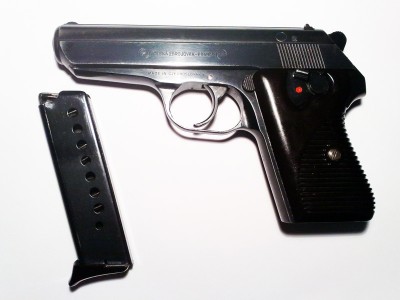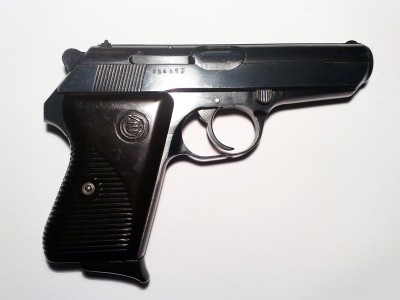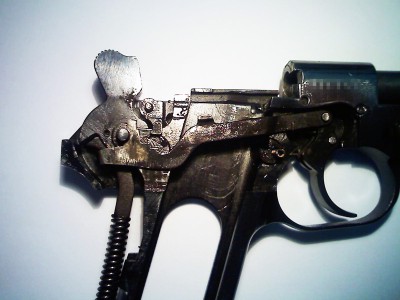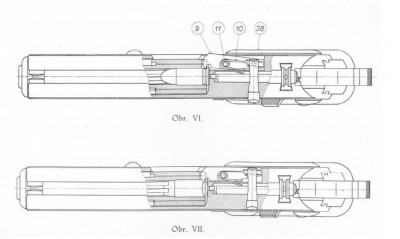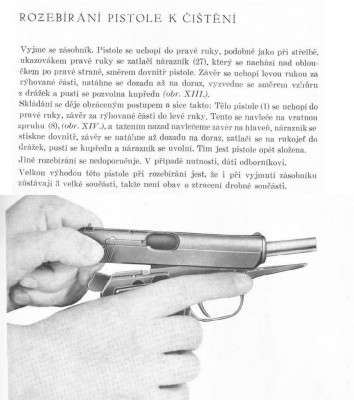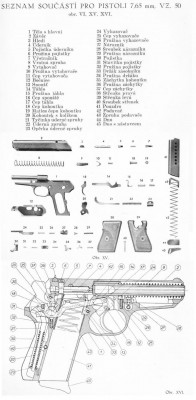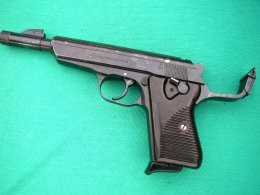| Název: Name: | Pistole vz. 50 / vz. 70 | Pistole vz. 50 / vz. 70 |
| Originální název: Original Name: | Pistole vz. 50 / vz. 70 | |
| Kategorie: Category: | samonabíjecí pistole | semi-automatic pistol |
| Výrobce: Producer: | Česká zbrojovka Strakonice, ČR Česká zbrojovka Uherský Brod, ČR | |
| Technické údaje: Technical Data: | ||
| Hmotnost nenabité zbraně: Weight Unloaded: | 0,70 kg | 1.54 lb |
| Ráže: Calibre: | 7,65 mm | |
| Náboj: Cartridge: | 7,65 Browning | |
| Délka: Length: | 167 mm | 6,57in |
| Délka hlavně: Barrel Length: | 96 mm | 3,78in |
| Kapacita zásobníku: Magazine Capacity: | 8 | |
| Výkony: Performance: | ||
| Rychlost střelby: Rate of Fire: | - ran/min | - rpm |
| Úsťová rychlost: Muzzle Velocity: | - m/s | - ft/s |
| Uživatelské státy: User States: | ||
| Poznámka: Note: | - | - |
| Zdroje: Sources: | Archiv autora | |
CZK - vz. 50, vz. 70
samonabíjecí pistole
ČZ vz. 50
Caliber: 7.65 Browning
Magazine: 8 capacity, metal, metal foot or plastic with thumb rest
Weight:
Velocity:
Rate of fire:
Manufacturer.
Note: was also introduced by postmen
The pistol has a dynamic breech, a plastic two-piece grip encircling the back of the weapon. It operates in SA/DA mode. The safety on the body is combined with a safety release of the cocked hammer. When the pistol is locked, the hammer can be cocked. The firing pin is secured by a vertical block safety.
The sights are fixed, small, poorly readable.
Caliber: 7.65 Browning
Magazine: 8 capacity, metal, metal foot or plastic with thumb rest
Weight:
Velocity:
Rate of fire:
Manufacturer.
Note: was also introduced by postmen
The pistol has a dynamic breech, a plastic two-piece grip encircling the back of the weapon. It operates in SA/DA mode. The safety on the body is combined with a safety release of the cocked hammer. When the pistol is locked, the hammer can be cocked. The firing pin is secured by a vertical block safety.
The sights are fixed, small, poorly readable.
Reklama
caliber: - the 7.65 Browning
length: 167mm
barrel length: 96mm
weight: 700g
magazine: 8 rounds
The peculiarity of the gun is the construction of the laser cutting which stands out when a loaded gun from the side of the conclusion.
length: 167mm
barrel length: 96mm
weight: 700g
magazine: 8 rounds
The peculiarity of the gun is the construction of the laser cutting which stands out when a loaded gun from the side of the conclusion.
Reklama
Pistol ČZ vz. 50/70 calibre 7,65 mm Br.
Applicants for a firearms license have encountered it and probably will for some time to come during the practical shooting and principles of weapon handling test. It is a gun that is quite often on store shelves for purchase at a very bargain price, raising suspicions if it is a gun at all. In short: it is a 'low-end' gun on the gun market, often derided and certainly undervalued. I will try to give you my experience of using this gun for many years.
It is a simple, responsive, reliable and accurate gun with a dynamic breech that houses open sights - non-adjustable sights, sights that are laterally adjustable by shifting in the herringbone groove. The weapon is loaded so that at a distance of 50 m the impact of the bullet coincides with the point of aim, at a distance of 25 m the point of impact of the bullet is 10-12 cm above it.
Reliability is due to its simplicity (the pistol disassembled for cleaning consists of 4 parts including the magazine), accuracy is due to the fact that it is a fixed barrel gun, shooting readiness is due to the DA trigger system, which allows to carry the gun unloaded with the cartridge in the chamber and the hammer cock cocked. Even so, the pistol is safe, as the initiation of a round by the firing pin (e.g., if the gun is dropped) is prevented by the firing pin safety. This blocks its movement until the trigger is released. The first shot can be fired by simply squeezing the trigger, but the resistance is noticeably higher (around 5 kN) and the stroke is longer. The next shots are fired with the hammer cocked, with a very short trigger travel and a resistance of at least 2 kN. The single-row magazine holds 8 rounds.
Although the pistol is designed for a cartridge which is currently considered to be underpowered for personal defence, nothing prevents its use for this purpose. For many decades, guns of this caliber have been used by police in this and other states as service pistols. This "50" and its successor, the "70", reliably served members of the SNB and later the Police of the Czech Republic from the early 1950s until the 1990s. It replaced in service the ČZ vz. 27 pistol of the same calibre, used since the First Republic. However, this highly successful weapon was much more complex, did not have a fixed barrel and, because it did not use the DA system, its firing capability was lower.
How to choose
The original design of the "50" was "improved" after twenty years and the "70" was created. The most recognizable difference from the original "50" is the more angular plastic handle, the manual safety wing has been shortened, the screw forming the axis of the drum cock has been changed and in some examples the shape of the cock has been changed. It must be said, however, that this "improvement" was not to the weapon's advantage, quite the contrary.
If I may recommend, if you buy it, prefer the original (rounded) pattern 50 and those pistols which are blued in brownish red. Guns that were originally in the SNB arsenal but were refurbished before being sold, while they were also re-brimed, so this "identifying feature" often cannot be used. In that case, select a pistol of the 50-52 vintage, if available. There is no need to worry about wear and tear, as despite their "age", the pistols have shot the minimum from their service.
In most cases, these pistols can only be bought "shot" nowadays, but this should not bother the interested buyer. Their durability is unexpectedly high - certainly higher than one would expect from their price. Surprisingly, the barrels have the highest durability - 20,000 shots will not affect them. The rest is worse.
What to look out for when choosing a ČZ vz. 50/70 pistol
External appearance: check for signs of wear, e.g. rubbed breech - especially on the edges, sights, etc., any impact marks on the sights, and other undesirable signs of excessive wear.
Remove the magazine and insert one cartridge. The pins must hold the cartridge at the same angle as they do, the cartridge must not "topple" upwards. Otherwise, the pins are stretched and reject the magazine, it would cause malfunctions - buckling of the fed cartridges. Test (with a rod, pencil, or similar instrument) that the magazine feed moves freely and that the feed spring has the necessary force.
Test the clearance in the grooves by cranking the slide sideways - it should be slight, but not excessive. Pull the slide several times to see if it runs smoothly. Pull the hammer cock and with gentle slow pressure test the trigger travel - length, resistance and whether it jerks - no jumps, steps and whether it has no drop after the "shot". Prevent the hammer from hitting the firing pin - your thumb will hold! Repeat the test several times.
Remove the slide. The barrel should have no signs of corrosion and there should be no carbon residue at the edge of the field. The gun should be clean - even in various hard to reach places e.g. the edge of the chamber - can be checked with a toothpick. Check the wear of the grooves on the slide and on the gun body - this is not a very informative finding.
The most noticeable is the breech wear at the point just behind the firing pin safety hole, where the top edge of the hammer cock strikes after the hammer cock is pulled all the way to the stop during the recoil motion of the breech after firing the bolt, and then returns by its own momentum. The rails milled into the breech create a ragged spot that can and does, over time, interfere with the firing pin safety hole and limit its momentum. This is a significant defect, because not only does the smoothness of the trigger safety and therefore the accuracy of the firing action depend on the smoothness of this safety, but also the fall safety of the pistol.
Hold the slide with the muzzle down and use a stick, pencil, pen, or other suitable object to push the firing pin safety inward. The firing pin, still concealed in the primer bed, must come out under its own weight. Its tip must be whole and round. When the safety is released, the primer must be concealed again. The safety spring must be sufficiently strong (the force required to compress the safety must be great). The fuse must move freely without jerking. Push the rear of the extractor inside the breech. It is swinging on a pin, the safety must be extended from the breech on the left side, the extractor claw must be swung out in front.
Try the side clearance of the hammer cock both extended and lowered. It should be only slight, especially important when the pressure is from the left. Its existence could indicate an irreparable defect and therefore a destroyed gun - the so-called "cracked eye". However, the defect can only be detected by a complete analysis of the pistol, which only a gunsmith is authorised to carry out. In use, this defect causes occasional malfunctions at first, but very soon the pistol stops firing altogether. That's about all they'll let you test in the shop.
The other tasks are more for the "advanced", but not too many: unscrew the connecting screw of the handguards and remove them. Check the visual condition and tightening of the drum cock axis nut on the right side - just by sight. The mechanism cover plate is tight against the pistol body, there should not be even a minimal joint. The nut must be in the position in which it is secured by the hex recess in the right hand stock. Do not over tighten it, as this could cause the right mechanism cover plate to warp and malfunction the gun.
Applicants for a firearms license have encountered it and probably will for some time to come during the practical shooting and principles of weapon handling test. It is a gun that is quite often on store shelves for purchase at a very bargain price, raising suspicions if it is a gun at all. In short: it is a 'low-end' gun on the gun market, often derided and certainly undervalued. I will try to give you my experience of using this gun for many years.
It is a simple, responsive, reliable and accurate gun with a dynamic breech that houses open sights - non-adjustable sights, sights that are laterally adjustable by shifting in the herringbone groove. The weapon is loaded so that at a distance of 50 m the impact of the bullet coincides with the point of aim, at a distance of 25 m the point of impact of the bullet is 10-12 cm above it.
Reliability is due to its simplicity (the pistol disassembled for cleaning consists of 4 parts including the magazine), accuracy is due to the fact that it is a fixed barrel gun, shooting readiness is due to the DA trigger system, which allows to carry the gun unloaded with the cartridge in the chamber and the hammer cock cocked. Even so, the pistol is safe, as the initiation of a round by the firing pin (e.g., if the gun is dropped) is prevented by the firing pin safety. This blocks its movement until the trigger is released. The first shot can be fired by simply squeezing the trigger, but the resistance is noticeably higher (around 5 kN) and the stroke is longer. The next shots are fired with the hammer cocked, with a very short trigger travel and a resistance of at least 2 kN. The single-row magazine holds 8 rounds.
Although the pistol is designed for a cartridge which is currently considered to be underpowered for personal defence, nothing prevents its use for this purpose. For many decades, guns of this caliber have been used by police in this and other states as service pistols. This "50" and its successor, the "70", reliably served members of the SNB and later the Police of the Czech Republic from the early 1950s until the 1990s. It replaced in service the ČZ vz. 27 pistol of the same calibre, used since the First Republic. However, this highly successful weapon was much more complex, did not have a fixed barrel and, because it did not use the DA system, its firing capability was lower.
How to choose
The original design of the "50" was "improved" after twenty years and the "70" was created. The most recognizable difference from the original "50" is the more angular plastic handle, the manual safety wing has been shortened, the screw forming the axis of the drum cock has been changed and in some examples the shape of the cock has been changed. It must be said, however, that this "improvement" was not to the weapon's advantage, quite the contrary.
If I may recommend, if you buy it, prefer the original (rounded) pattern 50 and those pistols which are blued in brownish red. Guns that were originally in the SNB arsenal but were refurbished before being sold, while they were also re-brimed, so this "identifying feature" often cannot be used. In that case, select a pistol of the 50-52 vintage, if available. There is no need to worry about wear and tear, as despite their "age", the pistols have shot the minimum from their service.
In most cases, these pistols can only be bought "shot" nowadays, but this should not bother the interested buyer. Their durability is unexpectedly high - certainly higher than one would expect from their price. Surprisingly, the barrels have the highest durability - 20,000 shots will not affect them. The rest is worse.
What to look out for when choosing a ČZ vz. 50/70 pistol
External appearance: check for signs of wear, e.g. rubbed breech - especially on the edges, sights, etc., any impact marks on the sights, and other undesirable signs of excessive wear.
Remove the magazine and insert one cartridge. The pins must hold the cartridge at the same angle as they do, the cartridge must not "topple" upwards. Otherwise, the pins are stretched and reject the magazine, it would cause malfunctions - buckling of the fed cartridges. Test (with a rod, pencil, or similar instrument) that the magazine feed moves freely and that the feed spring has the necessary force.
Test the clearance in the grooves by cranking the slide sideways - it should be slight, but not excessive. Pull the slide several times to see if it runs smoothly. Pull the hammer cock and with gentle slow pressure test the trigger travel - length, resistance and whether it jerks - no jumps, steps and whether it has no drop after the "shot". Prevent the hammer from hitting the firing pin - your thumb will hold! Repeat the test several times.
Remove the slide. The barrel should have no signs of corrosion and there should be no carbon residue at the edge of the field. The gun should be clean - even in various hard to reach places e.g. the edge of the chamber - can be checked with a toothpick. Check the wear of the grooves on the slide and on the gun body - this is not a very informative finding.
The most noticeable is the breech wear at the point just behind the firing pin safety hole, where the top edge of the hammer cock strikes after the hammer cock is pulled all the way to the stop during the recoil motion of the breech after firing the bolt, and then returns by its own momentum. The rails milled into the breech create a ragged spot that can and does, over time, interfere with the firing pin safety hole and limit its momentum. This is a significant defect, because not only does the smoothness of the trigger safety and therefore the accuracy of the firing action depend on the smoothness of this safety, but also the fall safety of the pistol.
Hold the slide with the muzzle down and use a stick, pencil, pen, or other suitable object to push the firing pin safety inward. The firing pin, still concealed in the primer bed, must come out under its own weight. Its tip must be whole and round. When the safety is released, the primer must be concealed again. The safety spring must be sufficiently strong (the force required to compress the safety must be great). The fuse must move freely without jerking. Push the rear of the extractor inside the breech. It is swinging on a pin, the safety must be extended from the breech on the left side, the extractor claw must be swung out in front.
Try the side clearance of the hammer cock both extended and lowered. It should be only slight, especially important when the pressure is from the left. Its existence could indicate an irreparable defect and therefore a destroyed gun - the so-called "cracked eye". However, the defect can only be detected by a complete analysis of the pistol, which only a gunsmith is authorised to carry out. In use, this defect causes occasional malfunctions at first, but very soon the pistol stops firing altogether. That's about all they'll let you test in the shop.
The other tasks are more for the "advanced", but not too many: unscrew the connecting screw of the handguards and remove them. Check the visual condition and tightening of the drum cock axis nut on the right side - just by sight. The mechanism cover plate is tight against the pistol body, there should not be even a minimal joint. The nut must be in the position in which it is secured by the hex recess in the right hand stock. Do not over tighten it, as this could cause the right mechanism cover plate to warp and malfunction the gun.
Pistol ČZ vz. 50/70 - part II. - defects and their elimination
The most common cause of defects in shooting is a jammed - unloaded charge. The fault is clearly caused by excessively open outlet glands. This is a consequence of long-term carrying of the full number of rounds in the magazines. Unfortunately, this is how most of the tanks on the market are devalued. It is well identifiable by the "willingness" of the upper charge to "topor" - described in Part I.
Removal (if it is not possible to replace the tank with a faultless one) consists in prevention - ie in that its full capacity is not used. Even a pistol charged with 6 rounds in the magazine and one in the chamber provides sufficient fire capacity.
Before each loading of the magazine into the weapon, the glands of the loaded magazine must be pressed against a solid object so that the upper charge is parallel to the edges of the gland.
Closely related to not delivering a charge is the failure of the breech - the jamming of the charge was not so strong as to completely prevent charging, yet sufficient that the energy of the returning breech was not sufficient for a perfect charge. The interrupter lever remains depressed and firing is not possible. Usually it is enough to reach the correct position with a palm blow - raw force.
Ammunition failure can occur due to the weapon when the weapon has been tampered with. In an effort to "relieve the trigger" by interfering with the trigger teeth - but also otherwise - the drum cock is released and strikes the firing pin before its safety by the trigger arm is sufficiently compressed and the firing pin is hit, especially during slow and "sensitive" launching. released. Then - if the match is "tapped" at all - the energy of the match is too low and not enough to initiate the incendiary composition. In a self-defense situation, it is sufficient to "press" the trigger with the DA. In this case, the striker fuse is always released and the charge is initiated. Also, when the trigger is pulled manually and pressed again, a shot is usually fired.
The occurrence of this defect should always lead to a visit to the armourer and the replacement of modified components - the trigger lever and the cock.
The manufacturer guarantees faultless operation of the weapon if the resistance of the trigger in SA mode of 2 kN and greater is maintained. In general, many years of experience with target shooting from this weapon lead me to claim that reducing the resistance of the trigger below 1.7 kN can cause defects in shooting, while the accuracy of shooting has a negligible effect.
Quite often it happened that the first blow to the item "went up". This did not happen with the automatic reloading of other shots. The difference was usually about 12-15 cm (on the target instead of "10" was "6" at the top). To eliminate this phenomenon, it was enough to move the target point on the first shot lower this distance, but mainly it proved to lubricate bullets by oiling on an oily cloth or foam - commonly used in the pistol Margolin 0.22 LR to ensure the automatic function of the weapon. No explanation has ever been given to explaining this phenomenon. I believe that carbon settles on the front edge of the charge chamber, and thus the charge is not fully reached into the chamber when the conclusion is returned relatively slowly. During the shot, the projectile is not immediately pushed into the bore, but a few hundredths of a millimeter flies freely and only then it hits the transition cone of the barrel. These nanoseconds of free movement of the projectile are manifested by an increase in the angle of stroke and thus the impact on the target of knowledge above.
Unauthorized modifications and tampering with the weapon mechanism
Although "rummaging in the pistol" was always forbidden, the great resistance of the trigger always led to attempts to reduce it. It is true that with the new series weapon, which has "almost four kilos on the trigger", accurate shooting is difficult to achieve. Weakening the drum strut is a nonsensical idea, it has no effect on the resistance of the trigger. The most important component of the trigger resistance is the force of the firing pin spring. Push the lock into the lower position (remember how it was inserted there!), Knock the striker backwards, then pull out the lock in which the spring is inserted.It can shorten by 1.5, maximum 2 threads. I do not recommend replacing it with a weaker one, it would not have to reliably secure the striker. After assembly, check the function of the fuse as described in the previous section.
At the same time, take a good look at the degree of hammering of the slats - described in Part I. If the fuse cannot be pulled out due to this, carefully remove the burrs interfering with the fuse "shaft" so that the fuse runs in it tightly but smoothly. This will also eliminate the "scrubbing" of the trigger in most cases.
The occurrence of further wear can be reduced by slightly sawing the upper part of the drum cock so that the area that devastates the milled bars at the end is significantly increased. You can find out the degree of sawing with the bolt removed and the cock extended: the resulting surface should be parallel to the path of the bolt and should slightly exceed it.
Under no circumstances interfere with the interlocking teeth of the trigger lever and the drum cock, not even by attempting to polish it, albeit the most subtle. The surface hardened layer is extremely weak and, in addition, these teeth fit into each other at a precisely determined angle, which you would certainly not observe.
Also, do not interfere with the spring of the trigger lever, although it sometimes seduces, because it is easily accessible and its weakening will actually reduce the resistance of the trigger quite a lot. However, the risk that the pistol will stop firing is just as great.
Only a rifleman is really entitled to another adjustment (try to stand behind his ass). The only spring left that will help reduce the resistance of the trigger is the hairpin, which lifts the trigger rod with the breaker at one end and returns the trigger forward at the other. However, only a rifleman can get to it - the result is a pistol, disassembled "dead" - all that remains is to dismantle the ejector, puller and press the barrel.
The spring can be "licked" slightly and evenly around the entire circumference "from inside the eye" with a round needle file - about a tenth, but all three threads. Before reassembling, all parts that slide, touch, etc. can be polished. The resulting effect is surprising, the resistance of the trigger is reduced from the original more than 3 kN to a pleasant less than 2 kN. Glare on the side of a semicircular fly can be uncomfortable in some lighting conditions. The rear part of the front sight can be sawed off, but this adjustment will really help only those who normally shoot an average of min. nines.
I wish you a lot of success - always in black and in one hole!
The most common cause of defects in shooting is a jammed - unloaded charge. The fault is clearly caused by excessively open outlet glands. This is a consequence of long-term carrying of the full number of rounds in the magazines. Unfortunately, this is how most of the tanks on the market are devalued. It is well identifiable by the "willingness" of the upper charge to "topor" - described in Part I.
Removal (if it is not possible to replace the tank with a faultless one) consists in prevention - ie in that its full capacity is not used. Even a pistol charged with 6 rounds in the magazine and one in the chamber provides sufficient fire capacity.
Before each loading of the magazine into the weapon, the glands of the loaded magazine must be pressed against a solid object so that the upper charge is parallel to the edges of the gland.
Closely related to not delivering a charge is the failure of the breech - the jamming of the charge was not so strong as to completely prevent charging, yet sufficient that the energy of the returning breech was not sufficient for a perfect charge. The interrupter lever remains depressed and firing is not possible. Usually it is enough to reach the correct position with a palm blow - raw force.
Ammunition failure can occur due to the weapon when the weapon has been tampered with. In an effort to "relieve the trigger" by interfering with the trigger teeth - but also otherwise - the drum cock is released and strikes the firing pin before its safety by the trigger arm is sufficiently compressed and the firing pin is hit, especially during slow and "sensitive" launching. released. Then - if the match is "tapped" at all - the energy of the match is too low and not enough to initiate the incendiary composition. In a self-defense situation, it is sufficient to "press" the trigger with the DA. In this case, the striker fuse is always released and the charge is initiated. Also, when the trigger is pulled manually and pressed again, a shot is usually fired.
The occurrence of this defect should always lead to a visit to the armourer and the replacement of modified components - the trigger lever and the cock.
The manufacturer guarantees faultless operation of the weapon if the resistance of the trigger in SA mode of 2 kN and greater is maintained. In general, many years of experience with target shooting from this weapon lead me to claim that reducing the resistance of the trigger below 1.7 kN can cause defects in shooting, while the accuracy of shooting has a negligible effect.
Quite often it happened that the first blow to the item "went up". This did not happen with the automatic reloading of other shots. The difference was usually about 12-15 cm (on the target instead of "10" was "6" at the top). To eliminate this phenomenon, it was enough to move the target point on the first shot lower this distance, but mainly it proved to lubricate bullets by oiling on an oily cloth or foam - commonly used in the pistol Margolin 0.22 LR to ensure the automatic function of the weapon. No explanation has ever been given to explaining this phenomenon. I believe that carbon settles on the front edge of the charge chamber, and thus the charge is not fully reached into the chamber when the conclusion is returned relatively slowly. During the shot, the projectile is not immediately pushed into the bore, but a few hundredths of a millimeter flies freely and only then it hits the transition cone of the barrel. These nanoseconds of free movement of the projectile are manifested by an increase in the angle of stroke and thus the impact on the target of knowledge above.
Unauthorized modifications and tampering with the weapon mechanism
Although "rummaging in the pistol" was always forbidden, the great resistance of the trigger always led to attempts to reduce it. It is true that with the new series weapon, which has "almost four kilos on the trigger", accurate shooting is difficult to achieve. Weakening the drum strut is a nonsensical idea, it has no effect on the resistance of the trigger. The most important component of the trigger resistance is the force of the firing pin spring. Push the lock into the lower position (remember how it was inserted there!), Knock the striker backwards, then pull out the lock in which the spring is inserted.It can shorten by 1.5, maximum 2 threads. I do not recommend replacing it with a weaker one, it would not have to reliably secure the striker. After assembly, check the function of the fuse as described in the previous section.
At the same time, take a good look at the degree of hammering of the slats - described in Part I. If the fuse cannot be pulled out due to this, carefully remove the burrs interfering with the fuse "shaft" so that the fuse runs in it tightly but smoothly. This will also eliminate the "scrubbing" of the trigger in most cases.
The occurrence of further wear can be reduced by slightly sawing the upper part of the drum cock so that the area that devastates the milled bars at the end is significantly increased. You can find out the degree of sawing with the bolt removed and the cock extended: the resulting surface should be parallel to the path of the bolt and should slightly exceed it.
Under no circumstances interfere with the interlocking teeth of the trigger lever and the drum cock, not even by attempting to polish it, albeit the most subtle. The surface hardened layer is extremely weak and, in addition, these teeth fit into each other at a precisely determined angle, which you would certainly not observe.
Also, do not interfere with the spring of the trigger lever, although it sometimes seduces, because it is easily accessible and its weakening will actually reduce the resistance of the trigger quite a lot. However, the risk that the pistol will stop firing is just as great.
Only a rifleman is really entitled to another adjustment (try to stand behind his ass). The only spring left that will help reduce the resistance of the trigger is the hairpin, which lifts the trigger rod with the breaker at one end and returns the trigger forward at the other. However, only a rifleman can get to it - the result is a pistol, disassembled "dead" - all that remains is to dismantle the ejector, puller and press the barrel.
The spring can be "licked" slightly and evenly around the entire circumference "from inside the eye" with a round needle file - about a tenth, but all three threads. Before reassembling, all parts that slide, touch, etc. can be polished. The resulting effect is surprising, the resistance of the trigger is reduced from the original more than 3 kN to a pleasant less than 2 kN. Glare on the side of a semicircular fly can be uncomfortable in some lighting conditions. The rear part of the front sight can be sawed off, but this adjustment will really help only those who normally shoot an average of min. nines.
I wish you a lot of success - always in black and in one hole!
On the very first photo they are storage reservoirs for vz.70, by comparing the shoes (shoe), it is seen that they are significantly more angular than in the picture my pistol. In addition, they have one more inspection hole in addition - I was with only one bullet?
By the way, those holes were, of course, in the bins for both weapons, but for the "50" are in a row below the other, for "70" is the lowest of the low outside line. The one for vz. 70 has the boot of a square, for 50 was rounded.
Existed as a full foot or without shoes - by the way the pressure of the little finger on the boot will cause interference down/up, so for accurate shooting it is not so good.
Boot not storage reservoirs for vz.27, and vz.52 (there is even using a stack rozebíralo)..
By the way, those holes were, of course, in the bins for both weapons, but for the "50" are in a row below the other, for "70" is the lowest of the low outside line. The one for vz. 70 has the boot of a square, for 50 was rounded.
Existed as a full foot or without shoes - by the way the pressure of the little finger on the boot will cause interference down/up, so for accurate shooting it is not so good.
Boot not storage reservoirs for vz.27, and vz.52 (there is even using a stack rozebíralo)..
Comparison of bundles:
Nine rounds can be loaded into the magazine for the Model 70, but the magazine cannot be inserted into the gun unless the slide is in the rear position. This is probably why the last hole is not the same as the others.
Nine rounds can be loaded into the magazine for the Model 70, but the magazine cannot be inserted into the gun unless the slide is in the rear position. This is probably why the last hole is not the same as the others.
Diskuse
Personally, this gun also known with "the boot" and when I saw the tray without it I thought it was an "accident" when it was plastic just offended. even in the book (MS small arms and machine guns) from the year 1971 is the gun taken with this tray (vz. 70 is not even mentioned) because of that issue it took some time (at least a year) hardly was a tray from 70ky. Another thing that for the presence of shoes indicates is a "strong inspiration" model of the Walther PP and the same "boot" is used, too.
The requirement that the weapon was "most similar to the PP" was even in 1948 in the award. And when it comes to the design of the fifties I think that they are signed by Jan and Jaroslav Kratochvílovi no p. Mouse (this at the same time he worked on ČZ448)
By the way, i mentioned the publication of this mentions(even much stronger than me) and I quote "the Design of the gun just followed up on known and proven German pistol Walther PP and was later put into production and into service with the designation vz.50. The requirement originated in the consequences of the problems with the gun vz. 38 and complex development of the vz. 52, MNO (which was the original by the client even if the payer was MV) just needed to resolve quickly and reliably the gun, later fifties introduced basically only in the police force (in the army it was just low).
The requirement that the weapon was "most similar to the PP" was even in 1948 in the award. And when it comes to the design of the fifties I think that they are signed by Jan and Jaroslav Kratochvílovi no p. Mouse (this at the same time he worked on ČZ448)
By the way, i mentioned the publication of this mentions(even much stronger than me) and I quote "the Design of the gun just followed up on known and proven German pistol Walther PP and was later put into production and into service with the designation vz.50. The requirement originated in the consequences of the problems with the gun vz. 38 and complex development of the vz. 52, MNO (which was the original by the client even if the payer was MV) just needed to resolve quickly and reliably the gun, later fifties introduced basically only in the police force (in the army it was just low).
Your contribution of 14.6.2005 "magazine for the CZ 50 has a smooth bottom of the stack and the body is provided with inspection openings in the tray for CZ 70 is the bottom of the plastic and serves as a rest for the little finger" he gave Karaco rise to discussion, which involved Drinking, Fantan, Tango and Bitaxe.
Using personal memories (Fantan) and professional literature (Bitaxe) we can come to agreement in the fact that the gun ČZ vz. 50 also had the bottom of the tray provided with a plastic rest for the little finger - as well as the ČZ vz.70, these restraints are varied in shape, for vz.70 was a square (on the very first fotu from Cichyho), for vz.50 were zaoblenějšího shape (on fotu from Fantana). There were also trays without the restraints of the little finger (see photo Piti), but they weren't too usual, and also in the book (MS small arms and machine guns) from the year 1971 is the gun taken with this tank..
Using personal memories (Fantan) and professional literature (Bitaxe) we can come to agreement in the fact that the gun ČZ vz. 50 also had the bottom of the tray provided with a plastic rest for the little finger - as well as the ČZ vz.70, these restraints are varied in shape, for vz.70 was a square (on the very first fotu from Cichyho), for vz.50 were zaoblenějšího shape (on fotu from Fantana). There were also trays without the restraints of the little finger (see photo Piti), but they weren't too usual, and also in the book (MS small arms and machine guns) from the year 1971 is the gun taken with this tank..
Gentlemen, I'm confused. Which is the correct value of resistance of the trigger of the gun vz. 50? Min. 2 cn or "four pounds on the trigger"? If the first, where is the tensioner that pulls the two tons? How it is constructed, because it must be a fantastic faster achievement! Or in zbrojařině does not refer to the abbreviation kN kilonewton? So what?.
#OBI-VAN GOBI: I'm not sure if You will be able to someone answer Your question. Most of the debaters above here already goes (the author of the article has left us, unfortunately, forever), I would recommend to contact directly to the sites of gun owners as arms.kvalitne (50/70) or marksmanship (50/70), or try to ask around at the gunsmiths ....
Join us
We believe that there are people with different interests and experiences who could contribute their knowledge and ideas. If you love military history and have experience in historical research, writing articles, editing text, moderating, creating images, graphics or videos, or simply have a desire to contribute to our unique system, you can join us and help us create content that will be interesting and beneficial to other readers.
Find out more